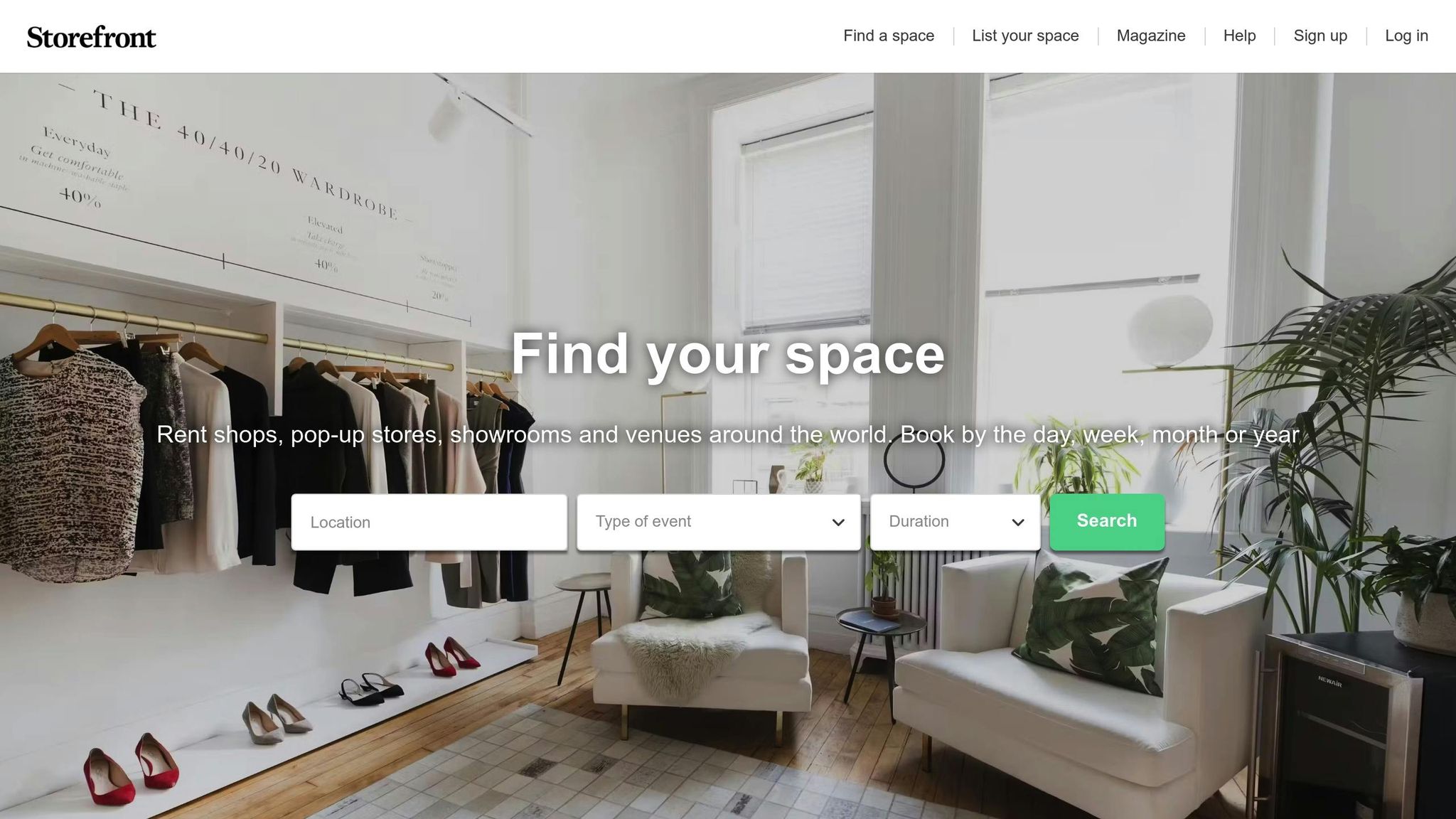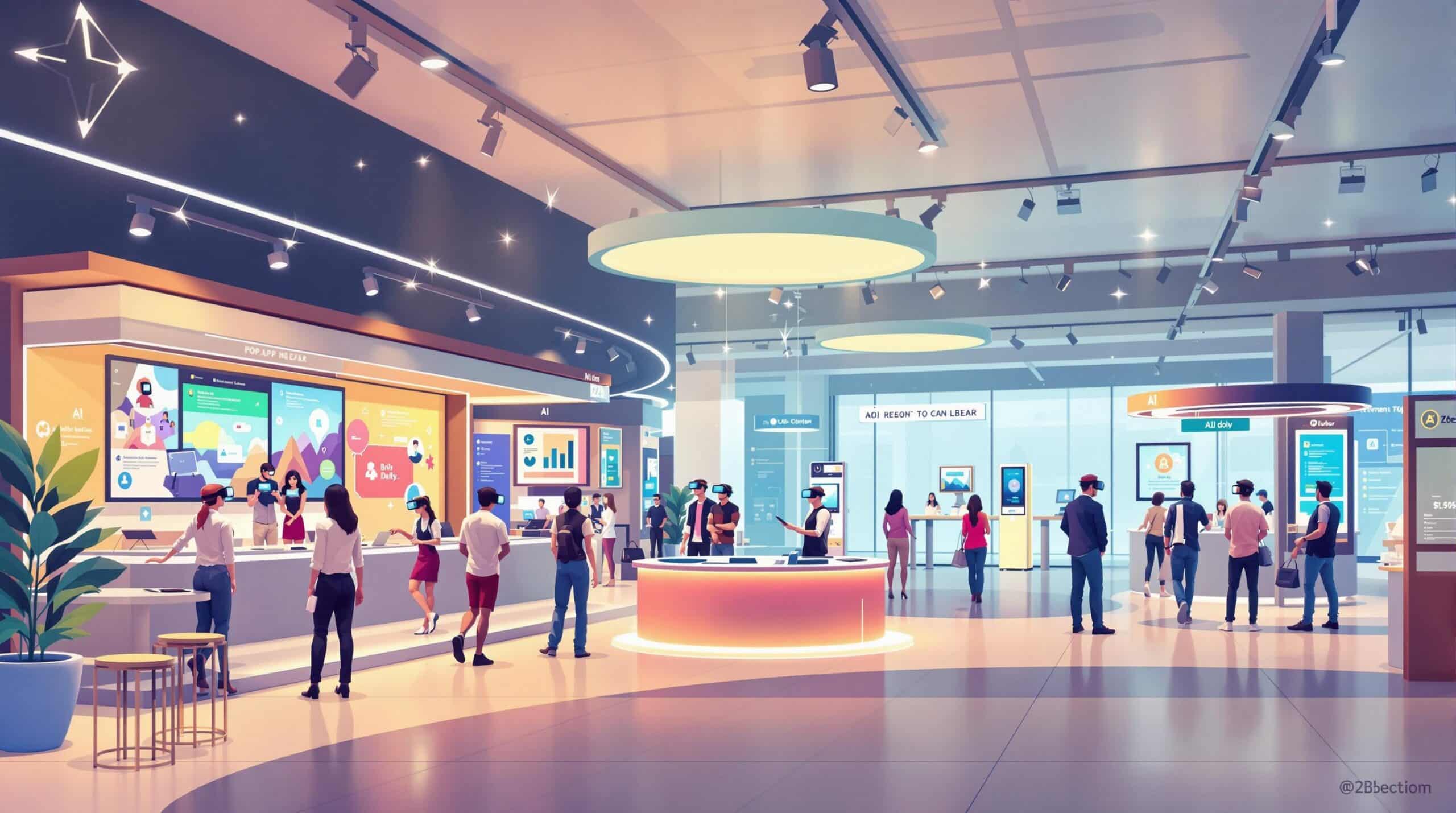Pop-up events are using digital tools like VR, AR, AI, and mobile apps to create interactive, short-term retail experiences. These technologies help brands engage customers, boost sales, and strengthen their message. Here’s what you need to know:
- VR/AR: Lets customers virtually try products or see them in real-world settings.
- AI Displays: Includes smart shelves, interactive mirrors, and chatbots for personalized experiences.
- Mobile Apps: Features like QR codes, location-based notifications, and virtual queues make shopping easier.
Key Results from Case Studies:
- Nike‘s AR booth increased time spent by 40% and add-to-cart actions by 25%.
- The Red Cross used AI displays and geotargeted ads to boost donations by 30%.
- Hard Rock Cafe’s mobile sweepstakes drove a 15% rise in store traffic.
These tools make pop-ups more engaging and drive measurable results. Next, learn how to plan and implement these strategies effectively.
Virtual pop-up stores for Storefront, powered by Obsess

Digital Tools in Pop-Up Events
Pop-up events use technologies like VR, AR, AI-powered displays, and mobile apps to turn temporary retail spaces into interactive brand showcases.
How VR and AR Enhance Experiences
Virtual and augmented reality bring products to life, even in small spaces:
- Let customers see how products fit into real-world settings.
- Offer virtual trials of physical items.
- Create engaging, 3D stories that connect with your brand.
Smart Displays and AI in Action
Digital displays and AI systems make pop-ups more interactive and tailored:
- Interactive mirrors: Allow virtual try-ons or product customizations instantly.
- Smart shelves: Keep track of inventory in real time to ensure accurate availability.
- AI chatbots: Provide automated, one-on-one support anytime.
Mobile Apps for Convenience
Mobile tools make it easier to attract customers and encourage purchases:
- Use location-based notifications to draw in nearby shoppers.
- Add QR codes for quick access to product details and payment options.
- Manage crowds with in-app appointment scheduling or virtual queues.
Up next, we’ll explore three examples of pop-ups successfully using these technologies.
3 Pop-Up Technology Examples
Here are three campaigns that highlight how VR/AR, data collection, and mobile-focused tools can make pop-ups more effective.
AR in Retail Pop-Ups
Nike used an AR-powered try-on booth at its NYC pop-up, leading to a 40% increase in time spent at the booth and a 25% boost in add-to-cart actions [1].
Interactive Data Collection
The American Red Cross combined digital displays with AI and geotargeted SMS/social media ads to promote pop-up blood drives. This approach led to a 30% increase in donations compared to the previous year [2].
Mobile-First Customer Experience
Hard Rock Cafe International incorporated a global sweepstakes into its mobile app, resulting in a 15% rise in in-store traffic during the campaign period compared to the prior year [3].
These examples show how well-executed digital strategies can improve engagement and deliver measurable outcomes for pop-ups.
sbb-itb-aebd855
Benefits and Limitations
Main Benefits
Using tailored digital tools in pop-ups can increase engagement, drive conversions, and boost sales. Real-world examples back this up: Nike’s AR booth increased dwell time by 40% and add-to-cart rates by 25%. The Red Cross saw a 30% rise in donations through AI-powered displays and geotargeted campaigns. Meanwhile, Hard Rock Cafe’s app-based sweepstakes led to a 15% jump in visit rates [1][2][3].
Next, let’s look at common technology challenges and ways to address them.
Implementation Guide
Here’s how to turn your plans into action. This guide outlines steps to ensure your pop-up’s VR, AR, AI, and mobile tools align with your brand’s goals and audience preferences.
Key Findings
A strong brand foundation paired with clear audience insights can drive noticeable increases in engagement and conversions for digital pop-ups.
Implementation Steps
-
Define brand positioning and success metrics
- Set specific goals and outline how you’ll measure success.
- Make sure your digital strategy aligns with your brand’s main objectives.
-
Choose the right digital tools
- Pick technologies that support your campaign’s key goals.
- Focus on tools that improve user experience and encourage interaction.
-
Plan and execute with testing and analysis
- Pre-launch: Refine your messaging, test your tools, and ensure everything is ready to go.
- Launch: Track key performance indicators (KPIs) and train your team for on-site execution.
- Post-event: Review the data, evaluate performance, and calculate your return on investment (ROI).
Business Impact
Digital pop-ups built on clear branding and targeted messaging have shown the potential to increase conversions by 18% or more. For example, CRC’s Microsoft campaign demonstrated this success [5].
FAQs
What should brands consider when selecting digital tools for their pop-up events?
When choosing digital tools for a pop-up event, brands should focus on tools that enhance engagement, streamline operations, and align with their event goals. Key considerations include:
- User Experience: Opt for tools that are intuitive and easy for both staff and attendees to use, such as interactive kiosks or mobile apps.
- Integration: Ensure the tools integrate seamlessly with your existing systems, such as CRM platforms or social media channels, to maximize data collection and post-event follow-up.
- Scalability: Choose solutions that can adapt to the size and scope of your event, whether it’s a small local pop-up or a large-scale activation.
By prioritizing these factors, brands can create memorable experiences and gather valuable insights to fuel future marketing strategies.
What are the best ways to measure the success of a pop-up event that uses digital technology?
Measuring the success of a pop-up event after integrating digital technology involves evaluating a mix of metrics and outcomes. Start by analyzing engagement data such as foot traffic, social media mentions, and interactions with digital tools like QR codes, AR experiences, or online surveys.
Additionally, track sales performance, both on-site and online, to determine if the event drove revenue. Compare pre- and post-event metrics like website traffic, email sign-ups, or app downloads to gauge broader audience impact.
Lastly, gather customer feedback through surveys or direct conversations to understand how attendees perceived the experience and whether it aligned with your brand goals. Combining these insights will provide a clear picture of your event’s success.
What are the common challenges of using VR, AR, and AI in pop-up events, and how can I address them?
Incorporating VR, AR, and AI into pop-up events can be exciting but comes with a few challenges. These often include high upfront costs for technology, the need for skilled professionals to design and implement these experiences, and ensuring a smooth, engaging experience across various devices and platforms.
To tackle these issues, start by aligning your technology choices with your target audience and event goals. Careful planning is key to ensuring the tech enhances your brand story without overwhelming the experience. Collaborating with experts, such as specialized brand strategy agencies, can help you create immersive, authentic experiences that captivate your audience and drive meaningful engagement.

